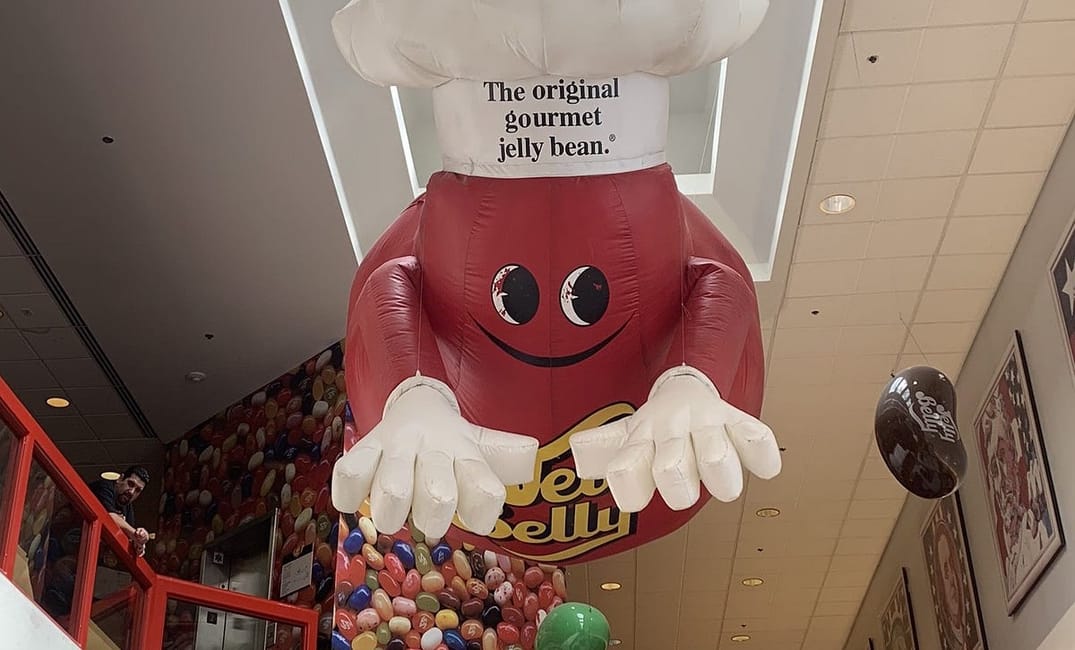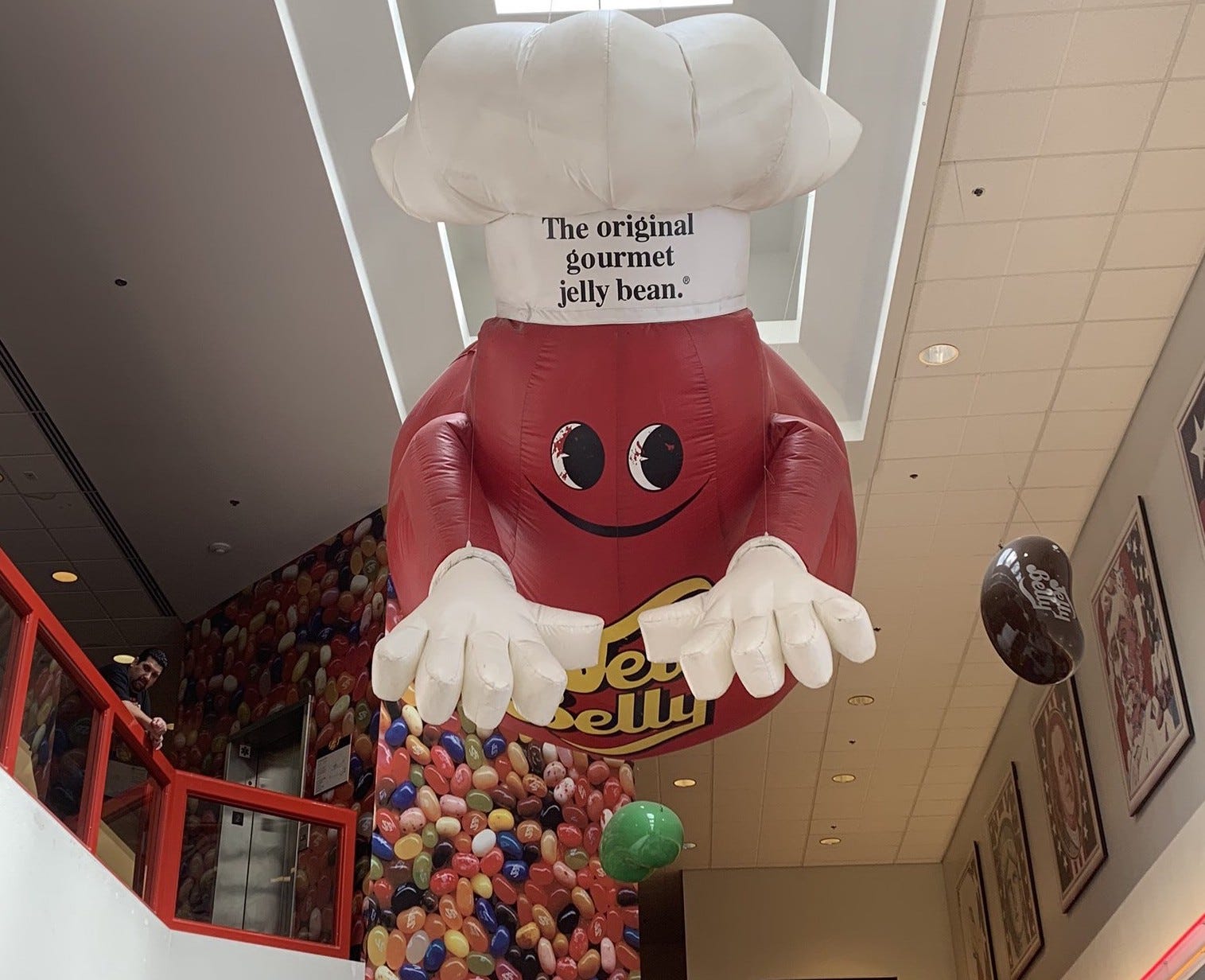
Sacramento is a city on the rise. With over 7,000 new residents in the last year alone, the capital has outpaced every other major city in the state in terms of growth.
But cheaper rents and higher temperatures aren’t the only things you’ll find in Sactown. There’s also plenty of good, old-fashioned weird. As the city’s director of tourism, Nick Leonti, told me, “Sacramento is about 80% weird stuff.”
“I mean, the city just got its first Michelin star, and it was awarded to the Kitchen Restaurant, which is literally behind a Taco Bell and across from the Ross Dress for Less,” said Leonti. “That pretty much sums up Sacramento. We’ve got amazing people doing amazing things, but we’re pretty chill about it. That attitude really allows quirky folks to excel.”
So when I set out to chart some of the quirkiest stops on the way to Sacramento, I didn’t have a hard time plotting a bizarre little 80-mile road trip. The following stops are great distractions, whether you’re passing through en route to Tahoe or, like me, hitting up Sacramento as your destination.
Stop 1: Home of the Martini
Located a little over 20 miles on the road is Martinez. Yes, lil ol’ Martinez is the birthplace of the classic, classy, strong-as-hell cocktail.
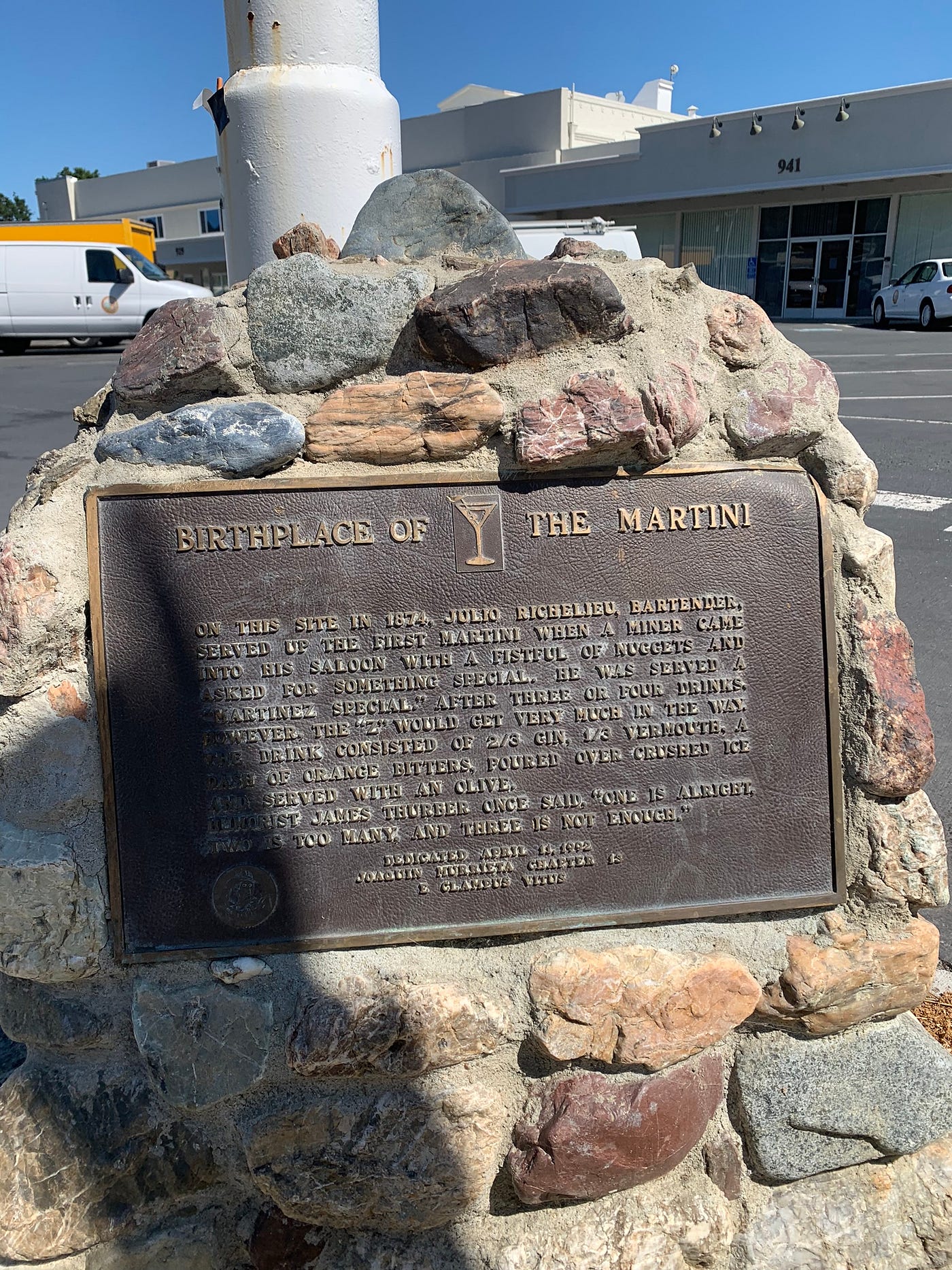
You can soak in this historical gem by checking out the plaque. Erected in 1992, it claims to sit on the actual “site” of the martini’s birth. Today, that site looks like a strip-mall parking lot. But no matter, as the legend makes up for it.
Evidently, a bartender named Julio Richelieu served the inaugural martini to a miner who walked into his saloon with a “fistful of nuggets,” asking for “something special.” Now I don’t pretend to have an intimate knowledge of the value of gold in 1874, but a “fistful” seems incredibly overpriced. Richelieu must have felt the same way because he served up a “Martinez Special” — the now-familiar mix of gin, vermouth, orange bitters, and olive. Evidently, after several refills, Martinez became “martini” out of the poor miner’s mumble-mouth.
This story is absolutely delightful, but the plaque’s location leaves you wanting more. My plan was to follow it up with a martini for myself, but given that it was 11:00 a.m. on a holiday and I didn’t have a fistful of nuggets to throw around, I had to forgo. Do yourself a favor, and come check this out for yourself on September 21, when, as a nearby sign informed me, the city hosts the Martinez traditional “Martini Shake Off.”
If you’re wondering if I used this trip as an excuse to visit the only Jelly Belly factory this side of the Mississippi without a child in tow, you’re absolutely right.
Stop 2: John Muir’s Scribble Den
After you’re thoroughly buzzed from a martini, have your designated driver head back toward Highway 4, and stop off at John Muir’s old house, now the John Muir National Historic Site. Sure, on its face it doesn’t seem all that “weird,” but it certainly qualifies as quirky.

Inside the visitor center (free admission, by the way), the friendly National Parks employee will offer to start the 20-minute video feature for you in the small theater room. Say yes. This film has everything: legitimate historical information plus top-notch reenactment drama. Among other things, you’re treated to a slow-motion reenactment of Muir stabbing himself in the eye. If you love conservation advocacy and infomercial-style acting, you’ll love this video.
Next, explore the house. As long as you heed the thousands of signs urging you not to touch a single damn thing, you’ll be fine. You’ll see such treasures as Muir’s “scribble den,” where he wrote many of his most impactful works on conservation during the last 10 years of his life. And if you can make it to the tippy top of the attic, you can ring a little bell. There’s something for everyone.
Stop 3: Jelly Belly Factory
If you’re wondering if I used this trip as an excuse to visit the only Jelly Belly factory this side of the Mississippi without a child in tow, you’re absolutely right. Another 25 miles along, you’re going to pull over in Fairfield and beeline it for 1 Jelly Belly Lane. The address alone tells you you’re in for a freaking treat.

As soon as you walk in, you’re surrounded by beans. They’re everywhere—the wallpaper, the carpet, the walls. Above you hangs a gigantic inflatable Mr. Jelly Belly. If you line up for a free self-guided tour, you can take a look at the factory, where all the magic happens. From the pouring of the bean molds to the polishing of their delicate outer coating, you’ll get a walking tour of jelly-bean creation and Jelly Belly’s corporate and cultural history. Did you know that Ronald Reagan was obsessed with Jelly Belly? Well, you do now. There’s a dedicated webpage about it in his presidential library.
Everyone gets jaunty little paper hats, which you’re required to wear during the tour (seems like a very thin health-code-compliance measure), and you can grab a couple of free packets of jelly beans on your way out. For a more cultured experience, hit up the wine-tasting room on the second floor. (I didn’t stop in, but I’m glad it exists.) Then, peruse the fine-art gallery, where you’ll find jelly-bean renderings of Mona Lisa, several presidents, and Batman.
Down in the gift shop, treat yourself to free samples, including such delights as “barf-flavored” beans, and check out chocolate versions of Nokia-esque brick phones and CDs. Edible tokens of a simpler time? No one can be sure.
“We’ve got amazing people doing amazing things, but we’re pretty chill about it. That attitude really allows quirky folks to excel.”
Stop 4: Giant Microscope
This one is going to be quick. There’s a 16-foot-tall, nonfunctional microscope sitting outside the Vacaville Art Gallery. Sculptor Phillip Glashoff evidently created the giant scientific instrument out of “fire extinguishers, a tractor bucket, and other recycled metal ‘junk.’”
If you need a pit stop in Vacaville, it’s worth a drive-by. Make sure you’re glammed up when you do, as it’s sitting pretty at number 3 on Vacaville’s list of the most “Instagram-worthy spots,” according to VisitVacaville.com. I, stupidly, did not get a selfie with the microscope, and I’m still thinking about it.
Stop 5: Dorothea Puente Murder House
You did it. You made it to Sacramento proper. Take a little drive down F Street, and stop when you hit house 1426. You’ll know it by the terrifying mannequin dressed up as an old lady on the front porch.
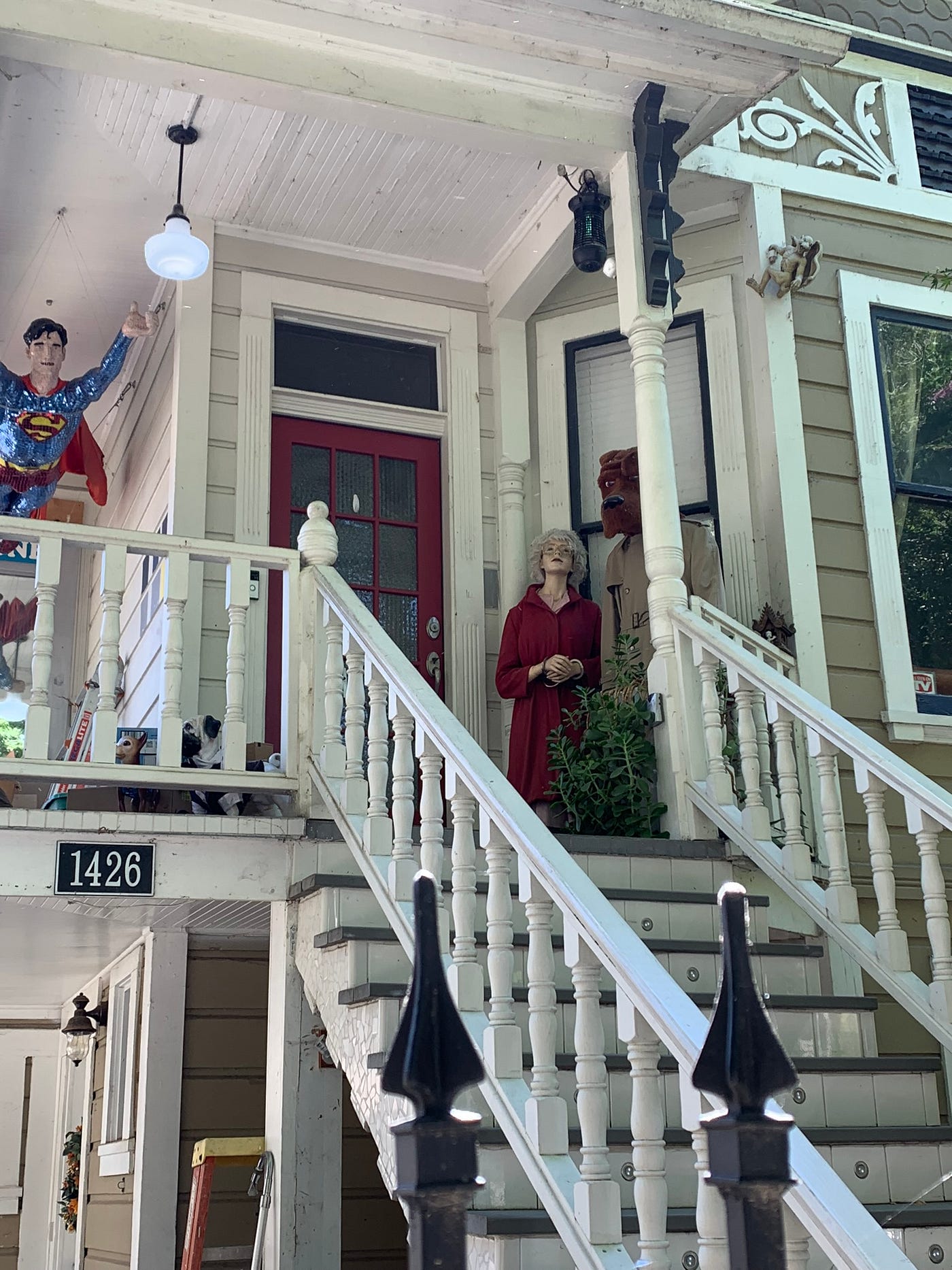
The mannequin is meant to convey the likeness of one Dorothea Puente, a white-haired old lady who was a convicted serial killer. She murdered several elderly and disabled tenants, then collected their Social Security checks. Puente was sentenced to life in prison, where she died in 2011. The house itself, however, lives on.
Outside you’ll find two separate plaques alluding to the murders. One reads, “It was that awful, awful woman that did it! Don’t blame me! — The House.” The other simply reads, “THE HOUSE IS INNOCENT.” These signs were baffling until I found The Atlantic’s mini-doc about the eccentric couple who bought the house. Watch it. This couple is wonderfully weird and truly made me appreciate the absurdity of the “murder house” itself.
I stood at the front fence for a solid 10 minutes taking in the goofy decorations and whimsical artwork, nearly forgetting that I was standing in front of the yard in which she buried many murdered tenants. Lest you forget, though, there’s the mannequin they artfully dressed up to resemble Dorothea, clad in a red coat to resemble the one she wore on the day when the first body was unearthed.
Last Stop: Osaka-Ya
At the recommendation of Nick Leonti, Sacramento’s director of tourism, I hit up Osaka-Ya on the way out of Sactown for a much-needed snack. The storefront is a tiny shop tucked away near the freeway on 10th Street. From a small window next to the shop’s entrance, they sell snow cones that start at an “extra small” size, which is as big as your face. If the line outside isn’t sign enough of Osaka-Ya’s popularity, take a look around.
“All the stores on the street — including Osaka-Ya itself — have signs posted that say ‘No Snow Cones Inside’…which is really odd unless you know someone is selling snow cones nearby,” said Leonti.
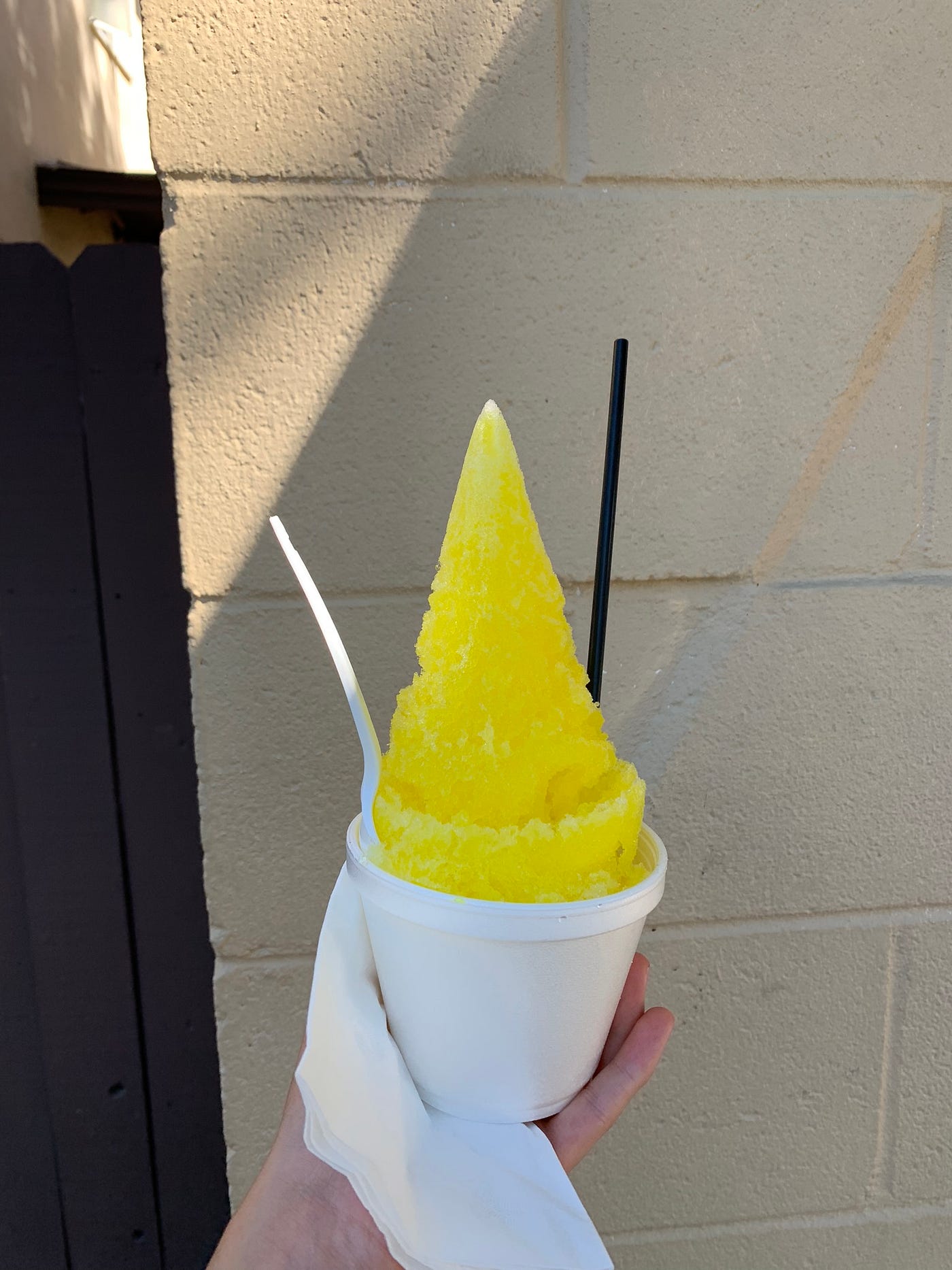
The shop has been selling manju and mochi since 1963 and says it’s one of only three remaining manju shops in Northern California. I was all about the snow cone, though. You can choose from an array of flavors, including something called Tiger’s Blood, which I was too scared to try. You can also add a scoop of ice cream underneath, extra syrup, or traditional toppings, such as condensed milk or sweet red beans. I went for an extra-small pineapple—which is actually massive—with vanilla ice cream and extra syrup. On a 97-degree day? Heaven.
With pineapple syrup still sticking to my hands, I reluctantly started my drive back to the Bay Area. Sacramento, it seems, was the perfect destination for such a trip.
Leonti describes the city as having a “history” of weird, stemming from the gold rush, when scrappy adventurers from all over the world arrived in droves. Today, that quirk certainly lives on.



